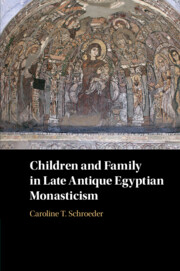28 results
Chapter 8 - The Ties That Bind
- from Part III - A Social History
-
- Book:
- Children and Family in Late Antique Egyptian Monasticism
- Published online:
- 18 September 2020
- Print publication:
- 17 September 2020, pp 160-190
-
- Chapter
- Export citation

Children and Family in Late Antique Egyptian Monasticism
-
- Published online:
- 18 September 2020
- Print publication:
- 17 September 2020
Chapter 2 - The Language of Childhood
- from Part I - Finding Children
-
- Book:
- Children and Family in Late Antique Egyptian Monasticism
- Published online:
- 18 September 2020
- Print publication:
- 17 September 2020, pp 50-66
-
- Chapter
- Export citation
Copyright page
-
- Book:
- Children and Family in Late Antique Egyptian Monasticism
- Published online:
- 18 September 2020
- Print publication:
- 17 September 2020, pp iv-iv
-
- Chapter
- Export citation
Abbreviations
-
- Book:
- Children and Family in Late Antique Egyptian Monasticism
- Published online:
- 18 September 2020
- Print publication:
- 17 September 2020, pp xii-xiv
-
- Chapter
- Export citation
Chapter 7 - Breaking Rules and Telling Tales
- from Part III - A Social History
-
- Book:
- Children and Family in Late Antique Egyptian Monasticism
- Published online:
- 18 September 2020
- Print publication:
- 17 September 2020, pp 145-159
-
- Chapter
- Export citation
Introduction
-
- Book:
- Children and Family in Late Antique Egyptian Monasticism
- Published online:
- 18 September 2020
- Print publication:
- 17 September 2020, pp 1-16
-
- Chapter
- Export citation
Figures
-
- Book:
- Children and Family in Late Antique Egyptian Monasticism
- Published online:
- 18 September 2020
- Print publication:
- 17 September 2020, pp ix-ix
-
- Chapter
- Export citation
Chapter 4 - Child Sacrifice
- from Part II - Representations
-
- Book:
- Children and Family in Late Antique Egyptian Monasticism
- Published online:
- 18 September 2020
- Print publication:
- 17 September 2020, pp 84-111
-
- Chapter
- Export citation
Part I - Finding Children
-
- Book:
- Children and Family in Late Antique Egyptian Monasticism
- Published online:
- 18 September 2020
- Print publication:
- 17 September 2020, pp 17-66
-
- Chapter
- Export citation
Part II - Representations
-
- Book:
- Children and Family in Late Antique Egyptian Monasticism
- Published online:
- 18 September 2020
- Print publication:
- 17 September 2020, pp 67-124
-
- Chapter
- Export citation
Contents
-
- Book:
- Children and Family in Late Antique Egyptian Monasticism
- Published online:
- 18 September 2020
- Print publication:
- 17 September 2020, pp vii-viii
-
- Chapter
- Export citation
Conclusion
- from Part III - A Social History
-
- Book:
- Children and Family in Late Antique Egyptian Monasticism
- Published online:
- 18 September 2020
- Print publication:
- 17 September 2020, pp 191-219
-
- Chapter
- Export citation
Bibliography
-
- Book:
- Children and Family in Late Antique Egyptian Monasticism
- Published online:
- 18 September 2020
- Print publication:
- 17 September 2020, pp 220-246
-
- Chapter
- Export citation
Chapter 6 - Making New Monks
- from Part III - A Social History
-
- Book:
- Children and Family in Late Antique Egyptian Monasticism
- Published online:
- 18 September 2020
- Print publication:
- 17 September 2020, pp 127-144
-
- Chapter
- Export citation
Acknowledgments
-
- Book:
- Children and Family in Late Antique Egyptian Monasticism
- Published online:
- 18 September 2020
- Print publication:
- 17 September 2020, pp x-xi
-
- Chapter
- Export citation
Dedication
-
- Book:
- Children and Family in Late Antique Egyptian Monasticism
- Published online:
- 18 September 2020
- Print publication:
- 17 September 2020, pp v-vi
-
- Chapter
- Export citation
Chapter 1 - Documenting the Undocumented
- from Part I - Finding Children
-
- Book:
- Children and Family in Late Antique Egyptian Monasticism
- Published online:
- 18 September 2020
- Print publication:
- 17 September 2020, pp 19-49
-
- Chapter
- Export citation
Index of Names and Subjects
-
- Book:
- Children and Family in Late Antique Egyptian Monasticism
- Published online:
- 18 September 2020
- Print publication:
- 17 September 2020, pp 250-256
-
- Chapter
- Export citation
Chapter 3 - Homoeroticism, Children, and the Making of Monks
- from Part II - Representations
-
- Book:
- Children and Family in Late Antique Egyptian Monasticism
- Published online:
- 18 September 2020
- Print publication:
- 17 September 2020, pp 69-83
-
- Chapter
- Export citation



